Form temporary dipoles - Study guides, Class notes & Summaries
Looking for the best study guides, study notes and summaries about Form temporary dipoles? On this page you'll find 45 study documents about Form temporary dipoles.
All 45 results
Sort by
 Popular
Popular
-
Chemistry 1010 Final Clemson University test with verified solutions 2024 latest update.
- Exam (elaborations) • 10 pages • 2024
-
Available in package deal
-
- $14.99
- 1x sold
- + learn more
Molecule Unit of matter that results when two or more atoms are joined by covalent bonds Ionic Bond A bond resulting from the electrostatic attraction of a cation for an anion. Brainpower Read More Nonpolar Covalent Bond A bond characterized by an even distribution of charge; electrons in the bonds are shared equally by the two atoms Polar Covalent Bond A bond resulting from unequal sharing of bonding pairs of electrons between atoms Polyatomic Ions Charged g...
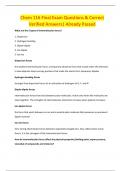
-
Chem 116 Final Exam Questions & Correct Verified Answers| Already Passed
- Exam (elaborations) • 14 pages • 2024
-
- $12.99
- + learn more
What are the 5 types of intermolecular forces? 1. Dispersion 2. Hydrogen bonding 3. Dipole-dipole 4. Ion-dipole 5. Ion-Ion Dispersion forces the weakest intermolecular force; a temporary attractive force that results when the electrons in two adjacent atoms occupy positions that make the atoms form temporary dipoles Hydrogen bonding forces stronger than dispersion forces its an attraction of hydrogen to O, F, and N Dipole-dipole forces intermolecular forces that exist between polar m...
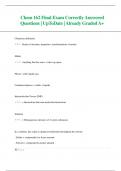
-
Chem 162 Final Exam Correctly Answered Questions| UpToDate | Already Graded A+
- Exam (elaborations) • 102 pages • 2024
- Available in package deal
-
- $14.49
- + learn more
Chemistry definition : Study of structure, properties, transformations of matter Matter : Anything that has mass + takes up space Phases: solid, liquid, gas Condensed phases = solids + liquids Intermolecular Forces (IMF) : = Interactions between molecules/atoms/ions Solution : = Homogenous mixtures of 2+ pure substances In a solution, the solute is dispersed uniformly throughout the solvent - Solute = compound(s) in lesser amount - Solvent = compound in greater amount 2 | P a g e E...
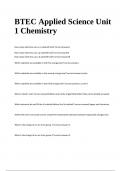
-
BTEC Applied Science Unit 1 Chemistry (Graded)
- Exam (elaborations) • 31 pages • 2024
-
- $12.99
- + learn more
BTEC Applied Science Unit 1 Chemistry (Graded) How many electrons can a d subshell hold? correct answer10 Which subshells are available in the first energy level? correct answers Which subshells are available in the second energy level? correct answers and p Which subshells are available in the third energy level? correct answers, p and d What is Hund's rule? correct answerOrbitals must all be singly filled before they can be doubly occupied Which elements do not fill the 4s subshell befor...
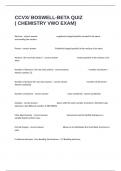
-
CCVX/ BOSWELL-BETA QUIZ ( CHEMISTRY VWO EXAM Complete Questions And Correct Detailed Answers.
- Exam (elaborations) • 15 pages • 2024
-
Available in package deal
-
- $14.49
- + learn more
Electron - correct answer negatively charged particle; located in the space surrounding the nucleus Proton - correct answer Positively charged particle in the nucleus of an atom Neutron ( for non ionic atoms ) - correct answer neutral particle in the nucleus of an atom Number of electrons ( for non ionic atoms) - correct answer = number of p...
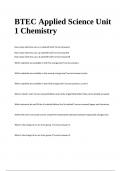
-
BTEC Applied Science Unit 1 Chemistry - Distinction.
- Exam (elaborations) • 31 pages • 2024
-
- $13.99
- + learn more
BTEC Applied Science Unit 1 Chemistry - Distinction. How many electrons can an s subshell hold? correct answer2 How many electrons can a p subshell hold? correct answer6 How many electrons can a d subshell hold? correct answer10 Which subshells are available in the first energy level? correct answers Which subshells are available in the second energy level? correct answers and p Which subshells are available in the third energy level? correct answers, p and d What is Hund's rule? correct ...
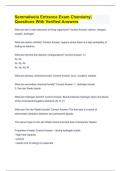
-
Semmelweis Entrance Exam Chemistry| Questions With Verified Answers
- Exam (elaborations) • 5 pages • 2024
-
Available in package deal
-
- $9.48
- + learn more
Semmelweis Entrance Exam Chemistry| Questions With Verified Answers What are the 4 main elements of living organisms? Correct Answer: carbon, nitrogen, oxygen, hydrogen What are atomic orbitals? Correct Answer: regions where there is a high probability of finding an electron What are the first few electron configurations? Correct Answer: 1s 2s, 2p 3s, 3p, 3d 4s, 4p, 4d, 4f What are primary chemical bonds? Correct Answer: ionic, covalent, metallic What are secondary chemical bo...
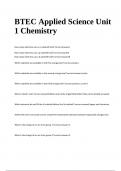
-
BTEC Applied Science Unit 1 Chemistry - Distinction.
- Exam (elaborations) • 31 pages • 2024
-
- $13.49
- + learn more
BTEC Applied Science Unit 1 Chemistry - Distinction. How many electrons can an s subshell hold? correct answer2 How many electrons can a p subshell hold? correct answer6 How many electrons can a d subshell hold? correct answer10 Which subshells are available in the first energy level? correct answers Which subshells are available in the second energy level? correct answers and p Which subshells are available in the third energy level? correct answers, p and d What is Hund's rule? correct ...
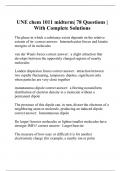
-
UNE chem 1011 midterm| 78 Questions | With Complete Solutions
- Exam (elaborations) • 10 pages • 2023
- Available in package deal
-
- $14.99
- + learn more
The phase in which a substance exists depends on the relative extents of its- correct answer: Intermolecular forces and kinetic energies of its molecules van der Waals forces correct answer: a slight attraction that develops between the oppositely charged regions of nearby molecules Londen dispersion forces correct answer: attraction between two rapidly fluctuating, temporary dipoles; significant only when particles are very close together instantaneous dipole correct answer: a flee...
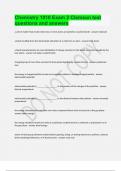
-
Chemistry 1010 Exam 2 Clemson test questions and answers
- Exam (elaborations) • 7 pages • 2024
-
- $13.49
- + learn more
a unit of matter that results when two or more atoms are joined by covalent bonds molecule a bond resulting from the electrostatic attraction of a cation for an anion ionic bond Brainpower Read More Previous Play Next Rewind 10 seconds Move forward 10 seconds Unmute 0:03 / 0:15 Full screen a bond characterized by an even distribution of charge; electrons in the bonds are shared equally by the two atoms non polar covalent bond charged group of more than one k...

That summary you just bought made someone very happy. Also get paid weekly? Sell your study resources on Stuvia! Discover all about earning on Stuvia


